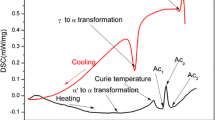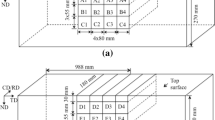Conclusions
-
1.
The cast steel quenched in the ingot mold exhibited after tempering exceptionally high secondary hardness (HRC 70-71) and red hardness (HRC 62 after tempering for 4 h at 640°C) but very low impact strength.
-
2.
Annealing and subsequent heat treatment slightly increased the impact strength of the cast steel, but lowered its secondary hardness (HRC 68–70) and red hardness (HRC 55–57).
-
3.
The forged steel was superior in strength and equal in secondary hardness to the cast steel, but was surpassed by it in red hardness (HRC 54–55).
-
4.
The steel produced by the powder metallurgy technique showed the least structural and chemical heterogeneity. After annealing it contained fewer chromium carbide and cementite-type carbide inclusions than did the cast and forged steels. After quenching and tempering the sintered steel was characterized by a fine grain, complete absence of any signs of dendritic structure, and a uniform distribution of extremely small carbide particles. It was less prone to overheating, contained less residual austenite than did the cast and forged steels, and could be more easily and evenly tempered. The sintered steel had high secondary hardness (HRC 66–70), while its red hardness was the same as that of the cast and forged steels (HRC 54–57). The sintered steel was less sensitive to changes in heat treatment conditions than the cast and forged steels. It also had a more homogeneous and stable structure and higher impact strength.
Similar content being viewed by others
Literature cited
Yu. A. Geller, Tool Steels [in Russian], Metallurgiya, Moscow (1975), p. 584.
A. Galkin, Yu. Chernyi, V. Koviko, and V. Spuskanyuk, “Improving the physicomechanical properties of R18 high-speed steel by hydraulic extrusion,” in: Production and Investigation of High-Speed and Die Steels [in Russian], Metallurgiya, Moscow (1970), p. 5.
V. G. Chikina, G. A. Khasin, and T. N. Popova, “Effect of high-temperature heat treatment (HHT) on the structure of high-speed steel,” in: Production and Investigation of High-Speed and Die Steels [in Russian], Metallurgiya, Moscow (1970), p. 26.
S. M. Saverina and T. A. Sladkova, Transactions of a Seminar for the Exchange of Experience between Central Factory Laboratory Workers and Technologists of Hot Shops of Tool Factories [in Russian], VNII, Moscow (1971).
Yu. V. Vinogradov, “An investigation into the effect of plastic working condition on carbide heterogeneity in high-speed steel,” Author's Abstract of Thesis, Moscow (1971).
R. D. Mininzon, “An investigation and development of means of improving quality in the production of high-speed steel,” Author's Abstract of Thesis, Leningrad (1972).
A. N. Popandopulo, A. A. Smirnov, and Yu. V. Vinogradov, “Effect of conditions of production of high-speed steel on tool life,” Metallorezhushchii i Kontrol'no-Izmeritel'nyi Instrument., No. 8, 6 (1974).
G. A. Meerson, S. S. Kiparisov, and S. I. Bogodukhov, Transactions of the Second Moscow City Scientific-Technical Conference on Powder Metallurgy [in Russian], NTO Mashprom, Moscow (1969), p. 36.
A. N. Popandopulo and M. E. Mormuleva, “Austenite recrystallization during the heating of annealed high-speed steel,” Izv. Vyssh. Uchebn. Zaved., Chernaya Met., No. 7, 126 (1970).
Author information
Authors and Affiliations
Additional information
Estimated composition: 8% W, 8% V, 7% Co, 6% Mo, Cr, and 1%C. The composition of the other steels referred to in this article, R18 and R6M5, are 18% W, 1.2% V, 4% Cr, and 0.75% N and 6% W, 5% Mo, 4% Cr, 2% V, and 0.85% C, respectively-Translator.
Translated from Poroshkovaya Metallurgiya, No. 11 (167), pp. 62–69, November, 1976.
Rights and permissions
About this article
Cite this article
Popandopulo, A.N., Gerashchenko, L.N. Structure and properties of cast, forged, and sintered R8F8K7M6 high-speed steels. Powder Metall Met Ceram 15, 868–873 (1976). https://doi.org/10.1007/BF00791785
Received:
Issue Date:
DOI: https://doi.org/10.1007/BF00791785




